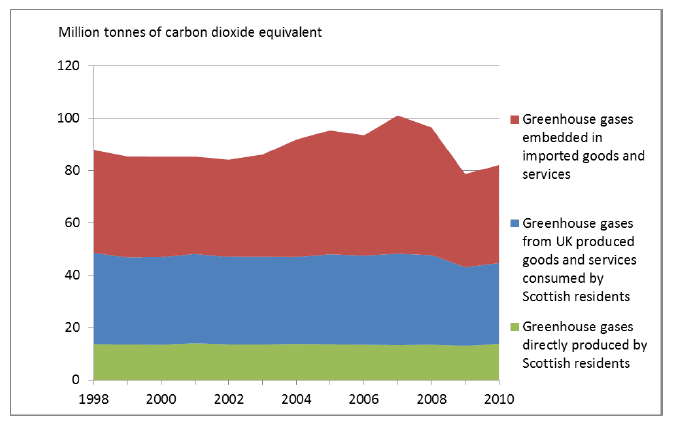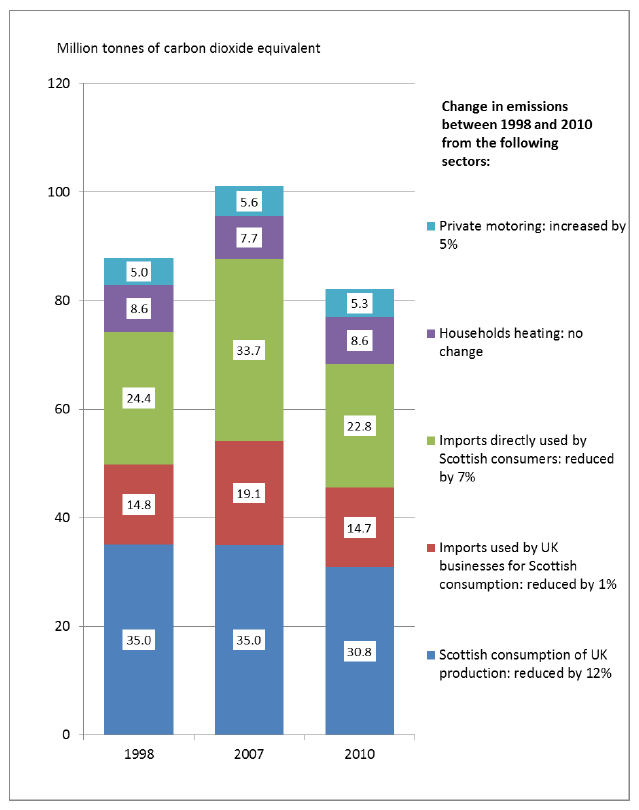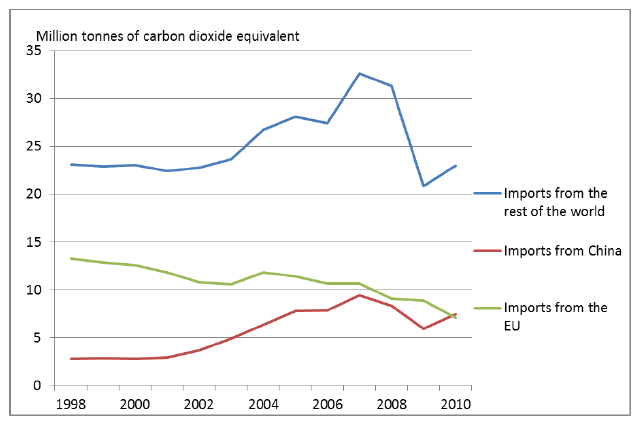Scotland's Carbon Footprint 1998 - 2010
This publication provides estimates of Scotland’s greenhouse gas emissions on a consumption basis; that is emissions that are associated with the spending of Scottish residents on goods and services, wherever in the world these emissions arise together with emissions directly generated by Scottish households.
Greenhouse gas emissions associated with Scottish consumption
Scotland's carbon footprint can be separated into a number of components: those generated directly by Scottish households through heating and private motoring, those emissions relating to goods and services produced by UK business, and those emissions relating to imported goods and services, broken down into imports from the EU, China and the Rest of the World. These are often referred to as emissions that are "embedded" in imports.
Figure 1 GHG emissions associated with Scottish consumption 1998 to 2010

Figure 1 shows that Scotland's carbon footprint rose from in 1998 to a peak in 2007 at 101.1 MtCO2e and since then has fallen 19 per cent to 82.2 MtCO2e, with a notably large dip occurring in 2009 before a slight rise in 2010. GHG emissions associated with imported goods and services accounted for around 45 per cent of Scotland's carbon footprint in 1998 (39.2 MtCO2e); by 2007 their share had increased to 52 per cent but by 2010 the share had fallen back to 46 per cent (37.5 MtCO2e). Indirect GHG emissions relating to Scottish residents consumption of UK produced goods and services fell 12 per cent from 35.0 MtCO2e to 30.8 MtCO2e between 1998 and 2010. GHG emissions generated directly by Scottish residents have remained relatively constant at around 13.5 MtCO2e, with a 2% increase between 1998 and 2010; the rise in 2010 being linked to the increased use of heating in a cold year.
Figure 2 Comparison of consumption based GHG emissions in 1998, 2007 and 2010

Table 1 Description of the main activities shown in Figure 2
| Activity |
Description |
|---|---|
| Scottish consumption of UK production |
UK production emissions attributable to Scottish final consumption, including manufacturing and transport, international aviation and shipping provided by Scottish operators. |
| Imports used by UK businesses for Scottish consumption |
Emissions associated with the production of imports which are used by UK industry and attributable to Scottish final consumption |
| Imports directly used by Scottish consumers |
Emissions associated with the production of imports which are used by Scottish final consumers |
| Private motoring |
Emissions generated directly by households through private motoring. |
| Household heating |
Emissions arising from households' use of fossil fuels for heating, households use of aerosols, etc. |
Between 1998 and 2010 there was a 6 per cent reduction in the Scottish GHG footprint. Figure 2 sets out the changes in each of five main activities that make up the total.
Emissions associated with UK production, (which excludes those directly generated by households), decreased by 12 per cent between 1998 and 2010. UK produced goods and services accounted for 37 per cent of the total Scottish GHG footprint in 2010, compared with 40 per cent in 1998.
Emissions associated with imports, both those directly used by consumers and those used by businesses, largely account for the increase in Scotland's carbon footprint between 1998 and 2007. Over this period emissions embedded in imports used by UK businesses for Scottish consumption increased by 29 per cent while emissions associated with the production of imports used directly by Scottish consumers increased by 38 per cent. However between 2007 and 2010, emissions associated with both categories have fallen to below 1998 levels. Overall embedded emissions from imports increased from 39.2 MtCO2e in 1998 to a peak of 52.8 MtCO2e in 2007 but have since fallen by 29 per cent to 37.5 MtCO2e in 2010.
The absolute amount of emissions generated directly by households has remained fairly constant at around 13.5 MtCO2e. Within the category, emissions from heating have fluctuated around 7.5 - 8.5 MtCO2e, depending largely upon the severity of the winter. Private motoring emissions increased between 1998 and 2006 due to an increase in travel by car. Reductions since then are in part due to the introduction of more fuel efficient vehicles.
Figure 3 Breakdown of consumption emissions by region of import

Figure 3 shows that emissions associated with imports from China have increased 164 per cent since 1998, from 2.8 MtCO2e in 1998 to 7.4 MtCO2e in 2010, and now account for 9 per cent of Scotland's carbon footprint as opposed to 3 per cent in 1998. Since 1998, emissions relating to EU imports have decreased 47 per cent to 7.1 MtCO2e in 2010, below the level for China. The absolute amount of emissions embedded in imports from the Rest of the World has reduced by 1 per cent since 1998 to 23.0 MtCO2e in 2010. These emissions have accounted for around 60% of embedded emissions in imports across the time period.
Contact
Email: John Landrock
There is a problem
Thanks for your feedback